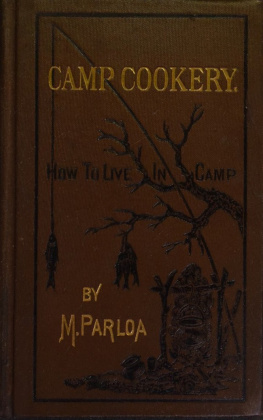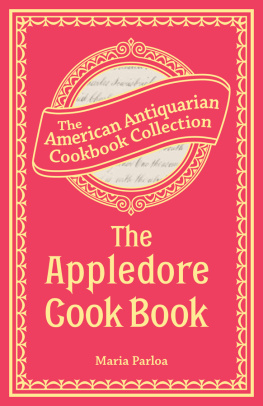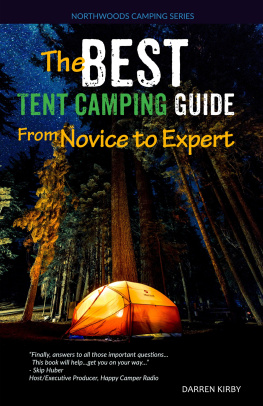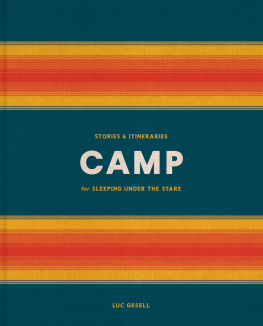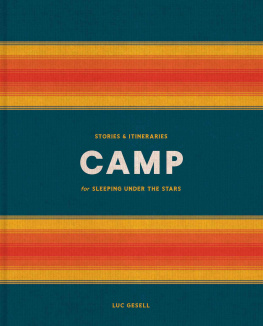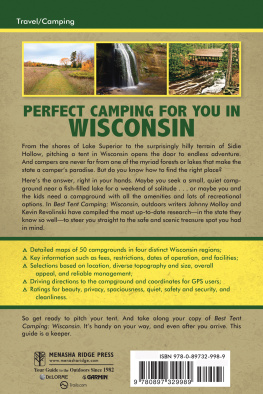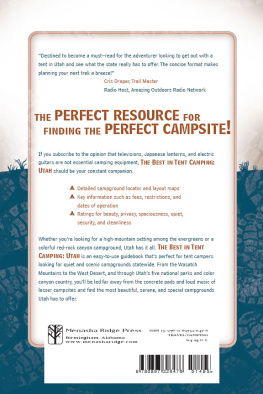Table of Contents
CAMP COOKERY.
HOW TO LIVE IN CAMP .
BY MISS M. PARLOA,
LECTURER ON SCIENCE OF COOKING, AND AUTHOR OF APPLEDORE
COOK BOOK, ETC.
OUTFITS FOR CAMPING,
AND
HINTS FOR COMFORT.
The first thing to parties bent on roughing it is the selection of a tent, which can be hired of any of the sail-makers, for any length of time, and at a reasonable price. For a party of seven or eight, an eight-foot wall-tent, is the best. Dig a trench around the outside to avoid nocturnal baptism the first time it rains. The beds can be comfortably arranged in the rear of the tent, by laying rubber blankets on the ground; on which lay boards slightly raised for the head, and sloping to the ground at the foot. These beds should be placed so that the persons will lie with their heads at the sides of the tent and feet toward the center. On the boards spread straw, hay, or dry seaweed, then the blankets. Every thing used about the bed should be laid in the sun every day. Some prefer sleeping on the ground rolled up in a blanket; but this is imprudent, except in very dry localities.
The next important thing is the stove. The top of a common cooking-stove with covers and stove-pipe to fit, which can be bought at any junk-shop for a trifle, serves very well in dry weather. Dig out a place in the side of a bank the size and shape of the stove-top, about two feet deep, and line three sides with brick or stones, with the front open. Regulate the draught by placing something in front for a blower.
The Lexington Camping-Stove , (which is the neatest, the most compact and convenient thing of the kind I ever saw), gotten up by the Lexington Botanical Club for their own use is just the article for camp. It is a box-stove, made of sheet iron, light, and quickly set up or taken down. It fits into a wooden chest which is thirty inches long, sixteen and a half deep, and fifteen broad. Into the stove fits a large water-tank; and, into the tank and one end of the stove, fit all the utensils for cooking and serving. When the stove is set up, the chest answers for a closet for stores, and also for a seat. This outfit is not prepared for the market by theorists who only guess at the wants of the camper, but has been studied out by gentlemen and ladies who, every year, spend months in the mountains, and who try to have all the comforts and conveniences possible, and yet to have very little baggage to transport from place to place. They have been using a similar stove for years; and we now have the result of continued improvements in the most perfect form of it. At my request, they have permitted their model to be used for the forming of others. They are made and for sale by J. A. Johnson, No. 5 Norfolk Place (opposite the Adams House). The whole cost of box, stove, and utensils will not exceed eighteen dollars.
Kerosene Oil Stoves are sometimes preferable, for they are easily transported, and can be used in wet or dry weather. The Boston Gem, made by Francis Morandi, No. 102 Union Street, I find, after a thorough trial, works to a charm; the oven baking as well as my stove oven. The broiler is so made that there is no difficulty in broiling with it. When in the woods, if possible, I would have a good bed of coals for broiling.
In regard to Cooking Utensils , coffee and tea pots should not have spouts, but lips: and the lips should be riveted on. It is foolish for a party going any distance to try to carry crockery. Have tin plates and cups made, and they will last you for all your camping life. They can be kept clean by occasionally scouring them with sand if on the beach, and with ashes if in the mountains; or, what is still better, with Sapolio, which rub on a cloth and then rub the tin with the cloth. Four or six cakes of this will give you much comfort and neatness. If you can carry a farina kettle with you, and you use it with care, it will be almost invaluable to you, as by that means you can always be sure that your oat-meal, hominy, rice, &c., will always be cooked without burning. Always be sure that there is water enough in the bottom kettle.
Cleanliness. It is very important that perfect cleanliness be observed in camp, as it adds much to health and comfort. When you pitch your tent, select a spot a little distance from it, for the refuse. Here dig a deep hole, if your stay is to be long, and into this hole throw the debris, each time covering with some of the earth which you have dug out. By this means you can keep the place clean and sweet.
Clothing. Both ladies and gentlemen should dress in flannel throughout. One change of under-flannel is enough extra clothes to carry, but be sure to take plenty of stockings. Have your boots well made and with broad soles. For hats, broad-brimmed felt hats are the lightest and coolest.
Soap. Carry plenty of soap for bathing, for washing dishes, and clothes. Take three or four pounds of baking soda with you to use for bathing purposes; and, if needed, for your mead and cooking.
Provisions for camp-life, will depend much upon the locality, and the requirements of the party; the following suggestions however, may be serviceable in making an outfit:
When it can be obtained take Heckers prepared flour, wheat, rye, Indian, or Graham. From this you will always be sure of good bread and griddle-cakes. Salt pork, smoked ham, bologna sausage, eggs, dried beef, salt fish. Game, fresh fish, and fresh meat are supposed to be obtained in the vicinity of camp. Pilot bread, crackers. Canned fruit and vegetables, where fresh cannot be obtained. Potatoes, beans, onions, Indian meal, molasses, sugar, salt, pepper, mustard, vinegar, butter, coffee, tea, chocolate, rice, oat-meal, baking soda, ginger, spice, soap, parafine candles, and kerosene oil.
The Essential Utensils are tin kettles with covers, coffee-pot, spiders with covers, gridiron, pans, basins, tin cups, pails, cans, knives, forks, spoons, lanterns, bags, ropes, strings, thread, needles, matches, shovel, axe, hammer, nails, slicking plaster, Jamaica ginger, fishing tackle, gun and ammunition, towels, stockings, and flannel garments. Each and every one of these articles may be found serviceable. The value of a match, a string, knife, a pin, or a pinch of salt, can never be realized, until in the woods or on the water the need of them has been felt. Parties scorning the idea of bothering with so many things when simply going out to rough it, will find it better to see that every thing is provided before starting; even then, they will find camp life rough enough.
CAMP COOKERY.
BIRDS.
In camp life, small and large birds should be either roasted, broiled, or stewed.
Pick all the feathers off, cut a slit in them, and draw them. Either wash or wipe carefully. If for roasting, tie the legs down, and place in the pan. Sprinkle with flour, cover the bottom of the pan with water, and roast, if ducks, thirty minutes, grouse and partridges the same.
Small birds, about half as long. The oven must be very hot.
Birds Roasted in their Feathers.
Open the bird in the usual manner, and draw it; then cover with wet clay, and bury in hot coals. In forty minutes, draw from the coals, and peel off the clay, when feathers and skin will come also.
A gentleman assures me that they are perfectly delicious cooked in this manner.
Broiled Birds.
Clean, and split down the back. Wipe dry, and broil over a clear fire, if small, ten minutes, but, if large, fifteen.
Season with salt, pepper, and butter, and serve on toast.
Stewed Partridges or Pigeons.
Place two partridges in a small kettle, and dredge with salt, pepper, flour, half teaspoonful of mace, half of cloves, and cover with cold water. Cover tight, and simmer two hours. Thicken with three spoonfuls of flour, and stir in two spoonfuls of catsup; simmer one hour longer, and serve. Grouse and pigeons are stewed in the same manner.

